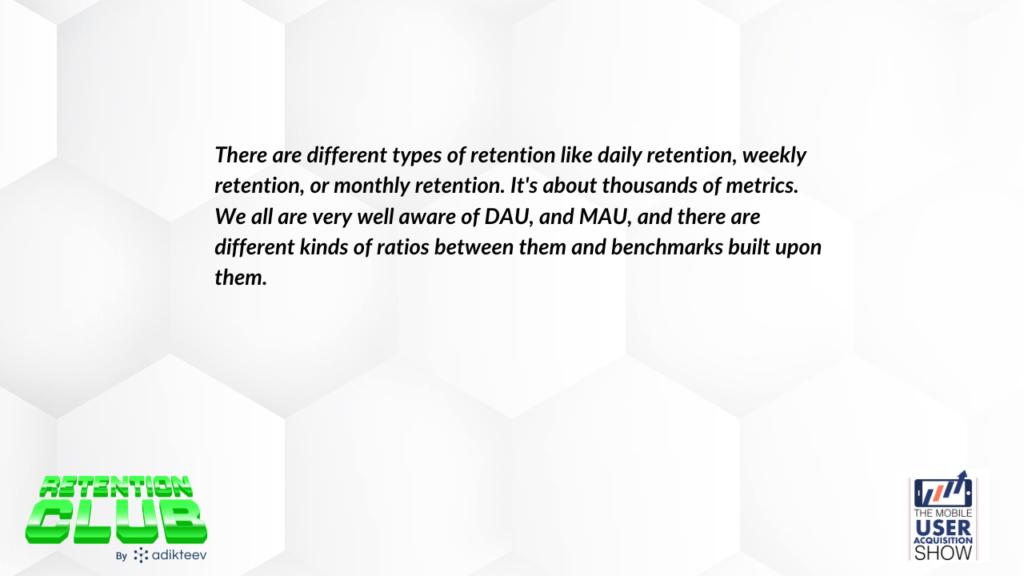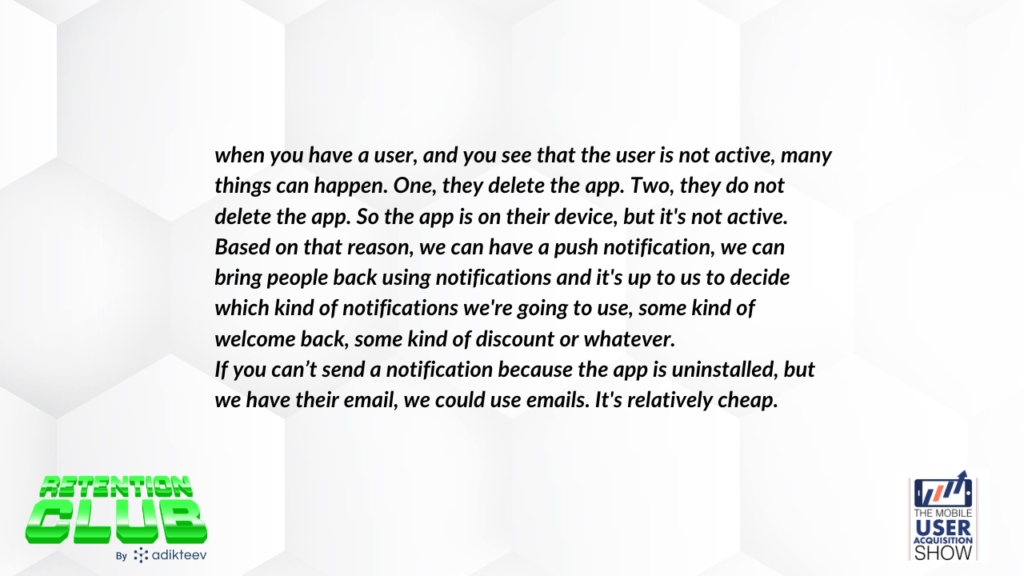
Our guest today is Nataliia Drozd, Marketing and UA Lead at Fabulous. Nataliia’s previous episode with us has remained one of the most popular ones of all time on our show.
In today’s episode, she sheds light on the intricacies of user behavior across different app categories, the impact of retention profiles, and strategies for optimizing subscription models.
Today’s episode is part of the Retention Club, a series of episodes on retention and re-engagement that are co-produced along with Adikteev.



ABOUT NATALIIA: LinkedIn | Fabulous
ABOUT ADIKTEEV: Website | LinkedIn | Retention Club
ABOUT ROCKETSHIP HQ: Website | LinkedIn | Twitter | YouTube
KEY HIGHLIGHTS
📌 Hybrid teams enhance retention and engagement.
🔊Retention requires understanding daily to monthly user activities.
♣️ Distinguish strategies for subscription vs. user retention.
🪐 Tailor retention strategies to app niche and user base.
🌊 Product quality naturally boosts retention and lowers cancellations.
🖥 Web onboarding offers strategic advantages but demands careful execution.
🗡 Effective re-engagement relies on precise user segmentation.
🛒 Creative tactics like loss aversion boost re-engagement success.
Shamanth
I’m excited to welcome back Nataliia Drozd to the Mobile UA show. Nataliia, welcome to the show.
Natalia
So happy to be back and to have a chance to talk to you Shamanth.
Shamanth
I’m excited to have you also because one of your episodes from two or three years ago, is still one of the most popular on our podcast and people still call that out.
Excited to dive into a completely different topic today in terms of retention and re-engagement, particularly from the lens of subscription apps.
Can you talk about the different types of retention profiles and how they impact engagement and user behavior in different app categories?
Natalia
When I talk about retention, we have to be sure that it’s usually the product field. Marketers do not work with retention. However, as we see that more and more teams are becoming more hybrid and better informed about different parts of the funnel, it’s a great thing for people who do media buying activities to be aware of how the whole funnel works.
Retention itself It’s just a word and what we have to do is to make sense of it and understand what it brings to us as a business, what we can do to improve it and why we, why we have to improve it or maybe not. So when we talk about product people, especially those who are responsible for activation and retention, we are always talking about user retention, which means people who are still active in your product.

But again, metrics without context do not mean much. To make things even funnier and interesting, when we talk about retention, there is a different way of looking at retention, which is about money. On top of just having user retention, we can have subscription retention, and those are not the same things.
Shamanth
We’ll get into all of this, especially because subscription apps have a very unique dynamic and we will get into subscription retention. So talk to us about how a lot of people know and understand user retention and subscription retention.
Can you talk about how the strategies for optimizing for these two might differ? Because these are very different kinds of users. How might you approach them differently?
Natalia
Everything depends on your niche, your vertical, and your product.
For example, when you work with products like dating, you must have a lot of daily active users, no matter if they are monetized or not because for another segment to pay is to make sure they have a variety of people they want to meet. Those things are different, but a company needs to care about both.
Because in some cases you cannot monetize your app and your product well if you do not hook people well enough in terms of the usage or some great experiences from your product.
So the first thing, is that sometimes people forget to cancel their subscriptions. They will still be counted as active subscription users. Your app may be already uninstalled. So depending on what you need, you will have different questions to ask.
For example,

Whenever we have different products and different niches, there are different things, and different kinds of retention than you need.
For example, if you talk about travel, it’s very classic. You don’t use Airbnb every day, only when you go on vacation holidays or business trips.
On the other hand, when you have hyper-casual games, you use them pretty often for a short period. So it doesn’t make much sense to check the yearly retention. I don’t know people who are using the same game after a year.
Context matters and your product matters.
Shamanth:
I remember a friend of mine saying that the percentage of subscription app users with an active subscription, but who never log into the app is shockingly high. So these are users who maybe bought an annual subscription or monthly subscription, forgot about it, and never logged in. Or they bought an annual subscription and wanted to cancel, but they are counted as active users. They’re technically active, but they’re not active and happy users, if you will.
So I think there’s just a lot of nuance to understanding some of this.
Speaking of cancellations there are different ways to improve retention by reducing cancellations. Some are, let’s just say dark patterns, and some are much more legit.
Can you talk about some of the strategies for improving retention by reducing cancellations?
Natalia:
Build a good product because when you have a good product, you don’t have to care about your cancellations.
Until iOS 13 release, when you were uninstalling apps on iOS devices, your subscription was still active. It was very tempting to do apps for iOS because even though people were uninstalling their apps, it was almost impossible to cancel the subscription and there was no intuitive way to do it.
Google Play in this regard was way more user-friendly because, in the Google Play Store, there was always a possibility to go and check your active subscription and cancel it. And they send you an email reminding you that, Hey, your subscription is about to expire.
It’s very good from the user perspective, but it is the reason why five years ago, way more people were doing apps for iOS primarily, and then re-adjusting them to Android because it was easier to make money on iOS. But as I said, things changed when iOS 13 was released. I know that not many people talk about iOS 13 because we were all very much affected by iOS 14 with IDFA.
The first earthquake in the iOS world happened a year earlier. So this is why now when you have your application and you have a subscription, it’s relatively easy to unsubscribe. This is why for the last two years we have seen an increased amount of web onboardings and web subscriptions. So basically anything that makes users pay outside of the Play Store and App Store.
We have a beautiful example of Epic Games that’s trying to create their payment system, even though it’s not a realistic description, it’s a different story, but trying to have direct financial information of your customer without using Google Play or App Store as an intermediary.
Of course, they don’t want to do that. They don’t want to lose their percentage fees, but moreover, it’s just harder to unsubscribe on the web because it’s not a one-tap thing where you click no and it’s done. You have to either send an email to complaints or have a web account where you have to do it.
Sometimes people simply forget. The banking system is getting more and more advanced, you receive a notification that your money disappeared from your account, but it doesn’t happen with older people.
You may see that more and more startups that use web funnels are targeting older audiences. People who don’t know how to transcribe it easily because people like millennials and people in their 40s are usually very much digitally literate. This is why a lot of companies are sadly using people’s lack of knowledge for their benefit.
Shamanth:
A lot of active users are just people who don’t know how to unsubscribe, and I hadn’t thought about the fact that a lot of apps are going to the web to take advantage of this, but you’re right. With the web-based flows web-based onboardings and web-based funnels, how do you recommend that marketers think about planning and prioritizing for these as compared to app-only flows?
What are some of the challenges they must be prepared for? As you pointed out, the advantage is that the unsubscribes and cancellations could be much more favorable on the web. But what are some of the other things they should be thinking about?
Natalia:
It’s perfectly okay to make web funnels, web onboarding, and web payments. There are beautiful companies like Bubble who do it a lot. And they do it nicely, keeping in mind their users, their behavior, and their journeys. There are smaller companies who sometimes do it not in the best manner. But, to be honest, the same is happening on the App Store.
When we talk about diversification, if you have an app, but want to acquire paying users on web trial, first of all, you need a different skill set because you need developers who know how to build it. Then you need a product manager who can build it on board. Or you become the person who built the web onboarding and the web payment part.
We need to know how to work with a payment processor because it’s not Apple or Google who deal with your payments, but it’s rather a different way of selecting your payment processor, no matter how big or small it is, but it’s also not a one-tap thing to do. So it’s a technical setup.
Secondly, it’s the product itself, because we should treat the onboarding and the payment page as a separate experience. It may be different from the one you have on your app. We all know that building on the web is slightly harder because of the different devices, and how people can use it.
On top of that, it’s not all the challenges that you have because the other challenge is acquisition itself. After all, you will have to run different types of campaigns. Whenever you’re running any paid campaigns, whether you run app campaigns or web campaigns, you’re entering different auctions because whenever you have a pure app auction you’re only competing with other applications.
But the web is way bigger. You are competing with large income companies. Another thing is that not all people like web onboarding. Some people prefer to do the app onboarding itself just because it’s more trustworthy and people are becoming slightly more aware and afraid of leaving their credit card details on unknown sources.
It’s not a magic stick that’s going to solve your problems, but it’s a good way forward to diversify because we as managers, and marketers always have to manage the risks. And if at some point Google decides to change the fee from 30% to 50%, you need to find a way to deal with it.
The same happens with Apple. They suddenly decide to, for example, make all the products free. Maybe they can, because they’re Apple. It’s trillion-dollar companies that shaping the industry. Diversification of your risk is always a good strategy, but it should always be executed properly.
This is why if your team does not have enough resources, you just have to be very careful with the strategy. Choose the amount of bandwidth you have because it’s better to do a proper app execution rather than having a low-quality app funnel that breaks now and then because it’s also bad for the image of your company as a whole.
Shamanth:
You’re right that it’s very effort-intensive. And I think something I noticed is that a lot of companies underestimate the kind of complexity and effort that a web-based funnel takes. I think there’s a conception that they can just, set up a landing page and that is it, or have a five-question quiz and that is it.
It’s not nearly as easy as it can be a high-reward initiative, but it’s also very high effort. That’s something I think people should be mindful of just from everything you’re describing.
For re-engagement campaigns, what are some of the common ways you recommend segmenting users to target them?
Nataliia:
There are different types of users. There are active users and again, the way you define active users can be different. I’ve seen at least five definitions of active users, and they’re all legit. So, I highly recommend you go to your product manager and ask, what is the specific definition that we are using?
Because

The same applies to mobile messaging.
I don’t think many people do it this way. If you’re desperate, maybe that’s the way forward. But a more common way of talking to people or communicating to people is of course using re-engagement campaigns, but it’s not that easy these days.
It’s still possible to do it in Android because Google Ad IDs are in place but on iOS, it’s a puzzle. Thank you iOS 14 for making our life way more fun because it’s not that easy you can run a re-engagement campaign of people who for example had a trial but did not convert to paying subscriptions so you have a separate campaign for them to offer a better price.
The other thing is if you’re a startup it’s very hard for you to run a re-engagement campaign because very likely you’re going to stack in small sample sizes and any large companies like Facebook and Snapchat, don’t like small sample sizes because there are very little options that you can enter.
This is why it’s not that cheap to do this kind of re-engagement campaign, but iOS, well, it’s a different story. No IDFA, no re-engagement.
This is why we can say that all our ad campaigns, are sort of already re-engagement because there are going to be people who are reinstalling your app after seeing your ad, even though you were not initially targeting them.
Certainly. There’s just no way to exclude them very clearly. And with Advantage Plus, you can technically exclude some people. It’s not watertight because Apple is just not giving enough user data. It’s not a helpful UAC, it is never possible to exclude anybody.
And we just have to live with that on iOS. Although I would say I know some companies that have done retargeting with just opted-in users on iOS. But I think you also pointed out you can’t do it with small sizes of audiences. So you do need to have a fairly big user base to retarget often users, but also just even on Android, you do need a relatively large size of users to be able to do that.
But if you do, I think there are ways to make it work, but I think you need to have certain criteria in place I suppose.
I do believe that anything we do, we have to ask ourselves, why do we do this? And is it the best way to reach our goal? If we have a super great deal, for example, our product has been completely revamped with new onboarding and better pricing, then I would even send emails to our former users because we know they had a problem and now we have a better solution.
So technically better monetized, but if you just have a marketing budget and if you are deciding whether to do a risky influencer campaign or to run a re-engagement campaign, but you do not have a strong deal or something, nothing has changed in your app or game, is it the best way to increase user base and increase revenue?
Because again, we are all in business and the main goal is to increase the financial value of your company. And it’s not always about just spending on every type of campaign possible, but rather finding the best channel mix for specifically your case.
Shamanth:
What if the deal or offer is an incentive? Or if it’s just like get 30% off, get 30 free clients, do you think that’s generally effective as compared to “here’s a new level”, or “here’s a new cool feature in the app”?
I’m curious if you have thoughts on incentives, monetary or in-game currency incentives versus actual features that are new.
Natalia:
I do not know a lot about re-engagement campaigns because I haven’t run them recently. The best way of running re-engagement for me when I was doing this was about loss aversion that you are missing out on something because people don’t care about features.
People get excited about financial gain. But with financial gain, you are attracting a very specific audience, which has very specific pricing elasticity. So it’s not always people who need your product, it’s for the people who want discounts. No matter if they want it or not.
So we have to be very specific about how you work with them. You can do it properly, but it’s not always, it’s not exactly the audience that you want to have if you’re building a long-term and successful product. So anything regarding mystery or creating this anticipation feeling was working pretty well.
If you work in apps and you want to see some interesting re-engagement tactics and techniques,

When you work for fitness, it’s better to do it with emails because people do not want to always get notifications about daily workouts if they don’t do it. After all, they feel bad. Something like “I know you haven’t been using our app, but let’s give it a fresh start this March”, or “It’s not too late to start loving your body, start loving yourself today.”
Every channel has its user use case and it usually works.
Shamanth:
In terms of putting pressure in a subtle, funny way.
I love Duolingo. They’re like, you did not come back today, it’s kind of aggressive, but kind of funny.
Natalia:
They are very good at having their tone of voice, which is very different from other companies. Everyone talks about gamification these days.
But, I’m shouting out to a different company, Drops. I’m using their app for learning French. They also have the streak feature. The streak feature is something that makes people come back.
Shamanth:
This has been very instructive as it is every time I get to talk to you.
This is a good place for us to perhaps wrap up. Before we do that, can you tell folks how they can find out more about you and everything you do?
Natalia:
LinkedIn is the best place for you to find me.
Shamanth:
Thank you again for being on the show.
Natalia:
Thank you so much for inviting me.


